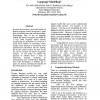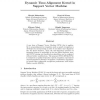TREC
1998
14 years 1 months ago
1998
We describe our submission to the TREC-7 Spoken Document Retrieval (SDR) track and the speech recognition and the information retrieval engines. We present SDR evaluation results ...
ACL
1997
14 years 1 months ago
1997
Although adequate models of human language for syntactic analysis and semantic interpretation are of at least contextfree complexity, for applications such as speech processing in...
ACL
1997
14 years 1 months ago
1997
A new language model for speech recognition inspired by linguistic analysis is presented. The model develops hidden hierarchical structure incrementally and uses it to extract mea...
COLING
2000
14 years 1 months ago
2000
We have implenlented a.n interactive, Wel)-based, chat-style machine translation system, SUpl)ort;ing speech recognition and synthesis, local- or thirdparty correction of speech r...
ANLP
2000
14 years 1 months ago
2000
Automatic generation of text summaries for spoken language faces the problem of containing incorrect words and passages due to speech recognition errors. This paper describes comp...
ACL
1998
14 years 1 months ago
1998
It seems obvious that a successful model of natural language would incorporate a great deal of both linguistic and world knowledge. Interestingly, state of the art language models...
NAACL
2003
14 years 1 months ago
2003
Automatic restoration of punctuation from unpunctuated text has application in improving the fluency and applicability of speech recognition systems. We explore the possibility t...
NAACL
2003
14 years 1 months ago
2003
It is well known that frame independence assumption is a fundamental limitation of current HMM based speech recognition systems. By treating each speech frame independently, HMMs ...
NIPS
2001
14 years 1 months ago
2001
A new class of Support Vector Machine (SVM) that is applicable to sequential-pattern recognition such as speech recognition is developed by incorporating an idea of non-linear tim...
NIPS
2001
14 years 1 months ago
2001
In the `missing data' approach to improving the robustness of automatic speech recognition to added noise, an initial process identifies spectraltemporal regions which are do...





